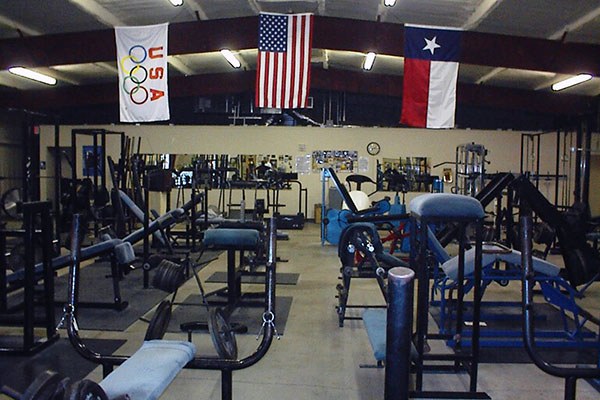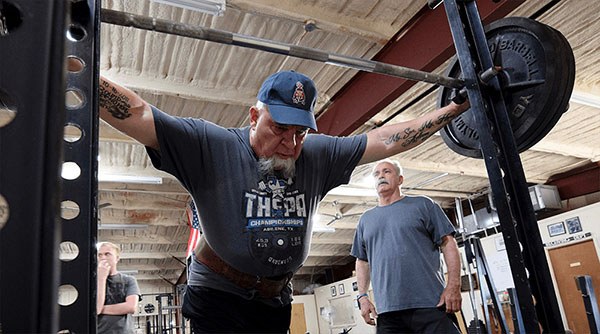April 1, 2024 is the 40th anniversary of the Wichita Falls Athletic Club. I thought I’d tell you about it.
I started training in 1976, just fucking around in the gym like all of you did before you wised up. I started in the weight room at Midwestern University, here in Wichita Falls, under the “guidance” of a faculty guy who should have been better at it than he was. A short time later I got a job as a pinsetter in a health club, a decent job for a college kid, but a job that didn’t teach me anything except about sales. It’s good to know about sales, because it’s good to know when you’re being sold to.
But the commercial health club business is not about fitness, or strength training, or anything other than sales, and I didn’t like it that much because I was actually getting interested in strength training. I started training for powerlifting meets, and lifted in my first intramural meet in 1978. The people running the meet didn’t know any more about it than I did, and it was a disaster, but I had fun anyway and decided to enter a real meet. I drove to Houston in 1979 for the USPF State Meet, where I actually totaled, but that’s about all.
I also met Bill Starr that year, 1979, while he was in town taking care of his daughter who had been injured in our famous tornado. He and I remained good friends until his death in 2015. Bill was instrumental in my ending up in this business, and staying in it.
Speaking of Wichita Falls, it may be the only 100K-market in the country that has not grown at all in the past 70 years. There are actually fewer places to eat here now than there was when my dad was running his cafe. At any given time there are 3 electrical contractors on the City Council, for some reason. We have an artificially-constructed waterfall on the highway that features muddy water running out of the cemetery, a big ugly sculpture in a park that cost $125,000 in 1982, and a water park owned by the city that was purchased in the middle of a drought to bail out the owners who were buddies of the Council. But I’m still here – inertia is a powerful force.
A great personal tragedy occurred to me later that year, and I moved to Colorado for a couple of years, training whenever I had time up there. I moved back to The Falls in 1981 to finish my geology degree, and began training at Anderson’s Gym. It was much better than the school weight room, and I got a lot of good progress accomplished with Starr coaching me. I was lifting in at least 3 meets a year during this time, learning a lot about the sport and the people involved in it.
The longer I trained, the more interesting the process became to me. So when David Anderson approached me about buying the gym from him, I accepted the offer immediately. I took the keys on April Fool’s Day in 1984, failing to appreciate the significance. I found a better location on Kemp Street – the main drag through town – and moved it three months later, and changed the name to Wichita Falls Athletic Club (modeled after the Texas Athletic Club owned by Mike Graham in Austin). I never liked gyms named after the owner. The place ought to be bigger than the guy, in my opinion. And if the owner is the strongest guy in the room, he’s probably not a very good coach.
I determined from the start that our training here was going to be barbell-based, even though it took me another 35 years to clarify exactly what that meant. But the first iteration of the gym was not specific to that purpose – it was a health club, as mainstream as I could make it, with machines, cardio, dumbbells, and a couple of power racks. I set up all the workouts for the new members who wanted the help, and while everybody squatted, benched, and deadlifted, I felt compelled to use the machines too. Because that’s what we did at the time. The picture was not yet in focus.
Business cruised along, with me teaching the barbell exercises to many hundreds of people, revising as I went, and learning more about the movements than I read anywhere else. I retired from competition in 1988, but I was still coaching lifters and taking them to meets. I started announcing meets about this time, and there was a period of time during which I announced most of the meets in Texas.
By the mid-1990s I had grown disillusioned with competitive powerlifting, primarily because of the supportive gear and the adoption of the monolift, which I regarded as having changed the nature of the sport. I shifted the emphasis of the gym in the direction of the Olympic lifts, changing my east room into lifting platforms and bumper plates, and I became involved with USA Weightlifting at the state-level.
In 2001, Carla Nichols, a coach who was working with me, and I moved the gym from the location on Kemp Street down the block to a building I purchased. It had to be emptied and remodeled, and I am no contractor, but I learned a bit about the process. We had some help from a very competent guy, Ralph King, who basically designed the project and told us what to do every day. We opened the new location on September 10, 2001. The day before 9/11. It was a slow couple of months.

So just for the hell of it, I decided to take some graduate classes in Exercise Science at MSU. That did not work out well. And possibly because of that experience, in 2004 I somehow got the silly idea that my opinions about training might be of interest to other people. I wrote the first edition of the book, titled Starting Strength: A Simple and Practical Guide for Coaching Beginners, with the assumption that high school coaches could use a reference for training their kids in the weight room.
Sales were disappointing. I determined that I had made a critical mistake in assessing the potential audience for the book, having suddenly realized that high school coaches do not/cannot read. I rewrote the book to reflect the actual target audience: the lifter. New pictures were taken, new art was created, and all the prose was changed to make the material more relevant to the end user.
At this point CrossFit took notice of the material and asked me to be involved as a Specialty Materials Expert. We bought some kettlebells and did some CrossFit workouts in the gym, affiliated with the national office as CrossFit Wichita Falls. I traveled extensively teaching our methods of barbell training in CrossFit affiliates all over the country until the end of 2009, when we developed our own courses and coaching products, which continue today.
I had several fundamental disagreements with CrossFit methodology, and my association with them forced me to codify my arguments and ultimately revise our approach to explaining the barbell exercises and strength training in general. Instead of “This is the way we do it,” it became “This is exactly why we do it this way.” I think we have made a significant contribution to strength and conditioning by proceeding from first principles, instead of wandering around using all the exercise machines, hopping around on colorful balls, and inventing new ways to do pushups.
Basically, the modern version of WFAC reflects the fact that we are a strength training facility, and strength is not produced by assistance exercises. Hundreds of millions of hours have been wasted in gyms all over the world by people who wanted to get stronger, but somehow “knew” that cable triceps exercises would make their bench press improve. Believe me when I tell you that this realization was not an easy one.
The idea of “primary exercises” that have to be supplemented with “assistance work” is such a foregone conclusion that it is difficult to think around it. Cable triceps stuff is fun, and you get to pretend to be Ronnie Coleman for a few minutes, but ask any self-aware lifter with 20 years experience under the bar if he thinks knee extensions made his squat go up. They didn’t, and he knows it, even if he’s never thought about it before.
We still have a few gym toys here at WFAC, because something about them makes them hard to get rid of. I’ve got dumbbells up to 128, an old incline bench, and a very old cable triceps machine that doesn’t get much use. My lat machine is a really good one from Mike Graham’s TAC, probably 60 years old, and very useful for warming up before chin-ups. My 45-degree leg press is an essential piece of equipment for older de-trained members. We have a glute-ham bench that nobody uses anymore, and a 45-degree hyperextension bench that I can’t even give away to anybody.

But
other than that, it’s all power racks, benches, bars, plates, and
platforms. It’s taken several leaps of understanding to pare it down
to these essentials, and the traditions of Fitness have fought us all
the way. There are very few institutions as hide-bound as the gym
business. There are several hundred thousand places to exercise all
over the world, and most of them are operated by people who will not
step back and ask questions like, what business am I really in –
selling memberships, or selling physical improvement? What exactly
makes me stronger, and what does all this other shit actually do?
What is the most efficient way to get stronger without wasting time
and money?
WFAC
is a very unusual place. It’s one of the oldest privately-owned gyms
in the country, maybe the world, given that gyms are usually
short-lived entities. We still have a few members hanging around that
have been here from the start, the poor things. Mike Morrison, Phil
Anderson (no relation to David), a few other who have not been here
quite that long. We’ve buried a few of our training partners –
Cardell Hairrill, Daryl Gallenburger, and John Wilson just last year.
and the place has a personality that has developed over the decades
that you can sense when you walk in.
These
days the gym is reserved for people who train our method. You have to
know the magic words to get in. A big bodybuilder guy and his big
bodybuilder wife came in a while back to look around. She asked me,
“Where do I do legs?” I said, “Gold’s Gym, across the street.”
Credit : Source Post


